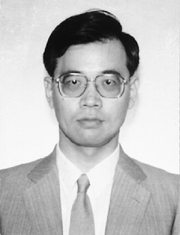
| Minoru Saito Parallel Application TRC Laboratory* |

| Minoru Saito Parallel Application TRC Laboratory* |
Profile Affiliation: Parallel Application TRC Laboratory, Tsukuba Research Center, RWCP Date of birth: November 21, 1954 Birthplace: Yashio City, Saitama Prefecture Background: 1985 Completed Ph.D. Course, Department of Physics, Postgraduate School of Science, Nagoya University 1987 Research Associate, Department of Physics, Postgraduate School of Science, Nagoya University 1988 Chief researcher, Protein Engineering Research Institute 1996 (since April) Current position
I have been responsible for parallel computing for molecular dynamics simulation in the field of computational chemistry at the Parallel Applications, TRC Laboratory since April of last year. My background may be slightly different from that of other researchers in RWC, so I shall describe it first.
I took my undergraduate, graduate, and Ph.D. courses in theory-oriented laboratories in the physics departments of the science schools at my alma maters. I learned the basic theory of physics such as quantum mechanics, statistical mechanics, and classical mechanics from Prof. Tetsuo Hamada during my undergraduate course at Ibaraki University. Prof. Hamada created the nucleic potential called "Hamada-Johnston Potential" at the University of Sydney, Australia using an electronic computer with vacuum tubes that covered an entire floor, at a time when there was no electronic computer in Japan. I went on to Kanazawa University for my graduate studies, majoring in materials science theory in the laboratory of Prof. Yasuaki Hiwatari. Prof. Hiwatari was one of the pioneers of molecular dynamics simulation in Japan, who called molecular dynamics simulations "computer experiments" rather than just simulations, to indicate that it is a third means of research that is neither experiment nor theory.
As I studied physics, I started to wonder how organic bodies with life had emerged from groups of atoms that had no personality or intention. I wished to understand more about how life is maintained, by using physics which describes the behavior of groups of atoms. To do this, I went to Nagoya University for my Ph.D. course at the Theoretical Biophysics Laboratory of Prof. Shigeo Yomosa in the Department of Physics, Postgraduate School of Science. Prof. Yomosa was one of the founders of the Biophysical Society of Japan, and was a global pioneer of the band computing of main chains of proteins in his younger days, by using a hand-operated computer. When I joined him, an abinitio molecular orbital method was being applied to small molecules without using empirical parameters in the field of theoretical chemistry. This method is rigorous, yet computation-intensive. After learning the abinitio molecular orbital method, I visited Associate Professor Hiroshi Kashiwagi at the Computer Center of the Institute for Molecular Science (currently a professor at the Kyushu Institute of Technology) to pursue the computation of the electronic state of organic molecules. Prof. Kashiwagi was then calculating molecular orbitals of an iron-porphyrin complex by the abinitio method using the entire memory and all the disks of the only large computer. I improved the program with several tens of thousands of lines written by the Kashiwagi Group to calculate the difference in stable structures due to the electronic state of iron-porphyrin. The results of my calculation agreed exactly with observations in experiments, although there was no adjustable parameter set to experimental values. I was greatly moved by this experience, namely, that no matter how long it took to calculate, calculation from first principles can describe the behavior of nature.
I then joined the Protein Engineering Research Institute (a ten-year project of MITI), which had just started, as a full-time chief researcher. At that time, all molecular dynamics simulations of protein were performed by omitting difficult calculations. I conceived a fast and accurate calculation method without omitting the difficult calculations and developed a new program. Using the combination of that program and the full power of the supercomputer installed at the Protein Engineering Research Institute, it was possible to accurately calculate the nature of protein, which had been impossible. This calculation style in which the full capacity of computers is used is inherited from Professors Hamada, Hiwatari, Yomosa, and Kashiwagi.
Even as computers advance, computational physics and computational chemistry will always require the fastest computers.